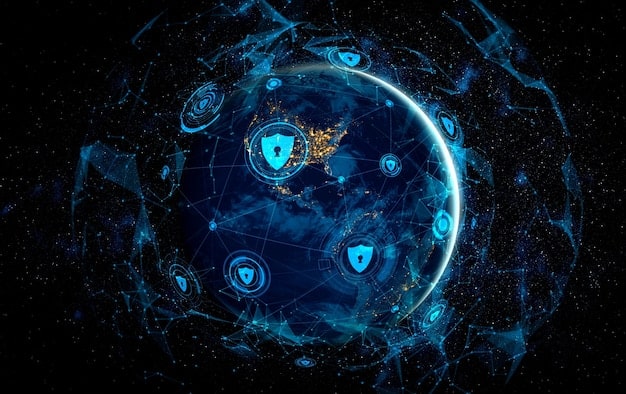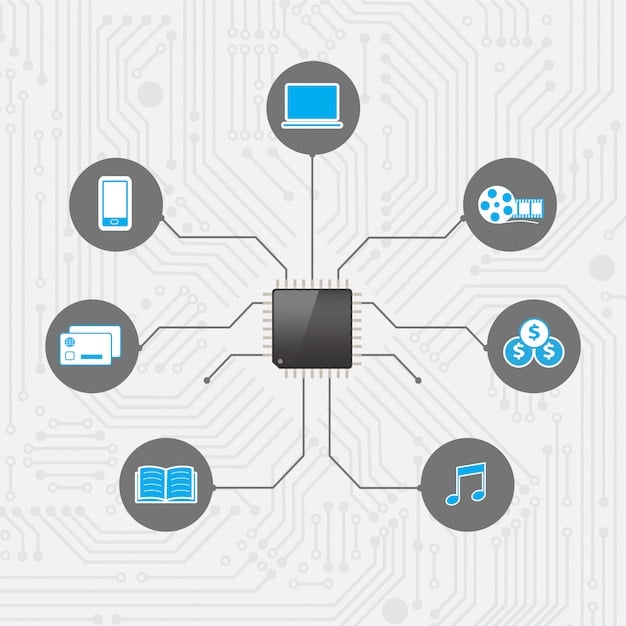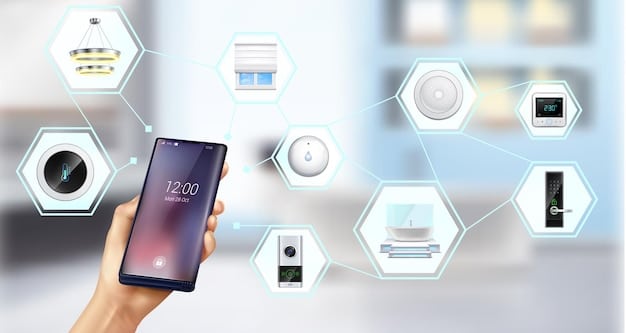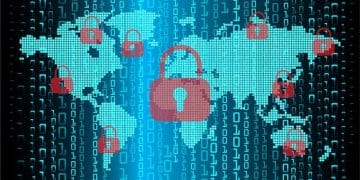The Future of Cybersecurity: Key Trends to Watch in the Next 5 Years

The future of cybersecurity will be shaped by advancements in AI, the increasing sophistication of ransomware attacks, the expansion of IoT devices, the growing skills gap, and the imperative for proactive and adaptive security measures.
The digital landscape is constantly evolving, and so are the threats that lurk within it. Understanding the future of cybersecurity: trends to watch in the next 5 years is crucial for businesses and individuals alike to protect themselves from emerging threats.
Navigating the Evolving Cybersecurity Landscape
The cybersecurity landscape is in perpetual motion, influenced by technological advancements, emerging threats, and evolving regulatory frameworks. Adapting to these changes is crucial for maintaining a robust security posture.
Over the next five years, several key trends are poised to reshape how we approach cybersecurity. These trends require proactive planning and strategic investments to mitigate potential risks.
The Rise of AI-Powered Cyberattacks
Artificial intelligence (AI) is rapidly transforming various industries, and cybersecurity is no exception. While AI offers powerful tools for threat detection and response, it also empowers malicious actors to launch more sophisticated attacks.
AI-powered cyberattacks can automate reconnaissance, identify vulnerabilities, and even craft highly personalized phishing campaigns. Defending against these attacks requires leveraging AI-driven security solutions to stay one step ahead.
- Enhanced Threat Detection: AI algorithms can analyze vast amounts of data to identify subtle anomalies that might indicate a cyberattack.
- Automated Incident Response: AI can automate incident response workflows, enabling faster containment and remediation of security breaches.
- Predictive Security: AI can predict future attack patterns based on historical data, allowing organizations to proactively strengthen their defenses.

In conclusion, the increasing sophistication of AI-powered cyberattacks necessitates a proactive and adaptive approach to cybersecurity, leveraging AI itself to enhance threat detection and response capabilities.
Combating the Growing Threat of Ransomware
Ransomware continues to be a significant threat to organizations of all sizes. The tactics employed by ransomware attackers are becoming increasingly sophisticated, making it more challenging to prevent and recover from these attacks.
From double extortion to ransomware-as-a-service (RaaS), the ransomware landscape is constantly evolving. Organizations must adopt a multi-layered approach to ransomware protection, including strong endpoint security, robust backup and recovery procedures, and employee awareness training.
Key Strategies for Ransomware Protection
Protecting against ransomware requires a comprehensive strategy that encompasses prevention, detection, and response. Implementing these strategies can significantly reduce the risk of a successful ransomware attack.
- Regular Data Backups: Maintaining up-to-date backups of critical data is essential for recovering from a ransomware attack without paying the ransom.
- Endpoint Security: Deploying robust endpoint security solutions, such as antivirus software and endpoint detection and response (EDR) tools, can prevent ransomware from gaining a foothold in the network.
- Employee Awareness Training: Educating employees about phishing scams and other social engineering tactics can help prevent them from falling victim to ransomware attacks.
The growing threat of ransomware demands a proactive approach to cybersecurity, emphasizing prevention, detection, and rapid response to minimize the impact of potential attacks.
Securing the Expanding Internet of Things (IoT)
The Internet of Things (IoT) is transforming the way we live and work, connecting billions of devices to the internet. However, the proliferation of IoT devices also introduces new security risks.
Many IoT devices are inherently insecure, with weak passwords, outdated firmware, and unpatched vulnerabilities. Securing the IoT requires a holistic approach that addresses device security, network security, and data security.

Addressing IoT Security Challenges
Securing the IoT requires a concerted effort from device manufacturers, service providers, and end-users. Implementing these measures can significantly improve the security posture of IoT ecosystems.
Manufacturers should prioritize security during the design and development of IoT devices, incorporating strong authentication mechanisms, encryption, and secure update capabilities. Service providers should implement network segmentation, intrusion detection systems, and other security controls to protect IoT networks from attacks.
- Device Authentication: Implement strong authentication mechanisms to verify the identity of IoT devices and prevent unauthorized access.
- Network Segmentation: Segment IoT networks from other networks to limit the impact of a security breach.
- Data Encryption: Encrypt sensitive data transmitted by IoT devices to protect it from eavesdropping.
- Regular Security Updates: Provide regular security updates to patch vulnerabilities and address emerging threats.
The expanding IoT landscape presents unique security challenges that require a multi-faceted approach, focusing on device security, network security, and data security to protect against potential vulnerabilities.
Bridging the Cybersecurity Skills Gap
The cybersecurity industry is facing a significant skills gap, with a shortage of qualified professionals to fill open positions. This skills gap is exacerbating the challenges of defending against increasingly sophisticated cyberattacks.
Addressing the cybersecurity skills gap requires a multi-pronged approach, including investing in education and training programs, promoting diversity and inclusion, and fostering collaboration between industry and academia.
Strategies for Closing the Skills Gap
Closing the cybersecurity skills gap requires a collaborative effort from governments, educational institutions, and the private sector. Implementing these strategies can help build a more robust and diverse cybersecurity workforce.
Governments should invest in cybersecurity education and training programs at all levels, from primary schools to universities. Educational institutions should develop curricula that align with the needs of the industry and provide students with hands-on experience. The private sector should offer internships, apprenticeships, and other opportunities for aspiring cybersecurity professionals.
- Investing in Education and Training: Supporting cybersecurity education programs can help build a pipeline of qualified professionals.
- Promoting Diversity and Inclusion: Creating a more diverse and inclusive cybersecurity workforce can bring fresh perspectives and innovative solutions to the table.
- Fostering Collaboration: Encouraging collaboration between industry and academia can help ensure that cybersecurity education remains relevant and up-to-date.
Bridging the cybersecurity skills gap is crucial for maintaining a strong defense against evolving cyber threats, requiring investments in education, diversity, and collaboration.
Embracing Proactive and Adaptive Security Measures
In today’s dynamic threat landscape, reactive security measures are no longer sufficient. Organizations must embrace proactive and adaptive security measures to stay ahead of emerging threats.
Proactive security involves anticipating potential threats and taking steps to prevent them from occurring. Adaptive security involves continuously monitoring the environment and adjusting security controls in response to changing conditions. By embracing these approaches, organizations can build a more resilient security posture.
Key Components of Proactive and Adaptive Security
Implementing proactive and adaptive security measures requires a combination of technology, processes, and people. These components work together to create a more resilient security posture.
Organizations should deploy threat intelligence platforms to gather information about emerging threats and vulnerabilities. They should also conduct regular vulnerability assessments and penetration testing to identify weaknesses in their systems. Security teams should be trained to recognize and respond to security incidents quickly and effectively.
- Threat Intelligence: Leverage threat intelligence to stay informed about emerging threats and vulnerabilities.
- Vulnerability Assessments: Conduct regular vulnerability assessments to identify weaknesses in your systems.
- Penetration Testing: Perform penetration testing to simulate real-world attacks and assess the effectiveness of your security controls.
Embracing proactive and adaptive security measures is essential for staying ahead of evolving cyber threats, requiring a focus on threat intelligence, vulnerability management, and incident response.
The Role of Cybersecurity in Remote Work Environments
The shift to remote work has created new cybersecurity challenges for organizations. With employees working from home, often on personal devices and networks, the attack surface has expanded significantly.
Securing remote work environments requires a combination of technical controls, such as virtual private networks (VPNs) and multi-factor authentication (MFA), and employee training. Organizations must also update their security policies to address the unique risks of remote work.
Best Practices for Securing Remote Work
Securing remote work environments requires a holistic approach that addresses device security, network security, and data security. Implementing these best practices can help organizations mitigate the risks of remote work.
Organizations should provide employees with secure devices and require them to use VPNs when accessing company resources. They should also implement MFA to protect against unauthorized access and train employees on how to identify and avoid phishing scams. Data encryption can also help protect sensitive information stored on remote devices.
- VPNs and MFA: Implement VPNs and MFA to secure remote access to company resources.
- Employee Training: Train employees on how to identify and avoid phishing scams and other cyber threats.
- Data Encryption: Encrypt sensitive data stored on remote devices to protect it from unauthorized access.
The increasing prevalence of remote work necessitates a comprehensive cybersecurity strategy that addresses device security, network security, and employee awareness to mitigate the unique risks associated with distributed work environments.
| Key Point | Brief Description |
|---|---|
| 🤖 AI-Powered Attacks | AI enhances attack sophistication, requiring AI-driven defenses. |
| 🛡️ Ransomware Evolution | Multi-layered protection including backups and training is essential. |
| 🌐 IoT Security Risks | Securing IoT requires holistic approach with authentication and encryption. |
| 💼 Skills Gap | Addressing the skills gap is crucial through education and diversity. |
Frequently Asked Questions (FAQ)
▼
The biggest threats include ransomware attacks, phishing scams, and data breaches. These threats can lead to financial losses, reputational damage, and legal liabilities for businesses of all sizes.
▼
Implement a multi-layered security approach including regular data backups, strong endpoint security solutions, and employee awareness training. These measures can significantly reduce the risk of a successful ransomware attack.
▼
AI plays a dual role in cybersecurity. It can be used to enhance threat detection and response capabilities, but also can be leveraged by malicious actors to launch more sophisticated attacks. AI-powered security solutions are crucial to stay ahead.
▼
Conduct regular risk assessments, implement strong security controls, train employees on security best practices, and stay up-to-date on the latest threats and vulnerabilities. Proactive cybersecurity preparedness is key to avoid major incidents.
▼
Employee training is crucial because employees are often the first line of defense against cyberattacks. Educating them about phishing scams, malware, and other threats can help prevent them from falling victim to attacks.
Conclusion
As we look to the future of cybersecurity, it’s clear that proactive planning, continuous adaptation, and ongoing investment in security measures are essential for protecting against evolving threats. By staying informed and embracing these key trends, organizations and individuals can navigate the complex cybersecurity landscape with greater confidence.





